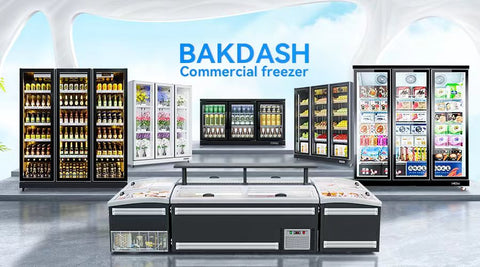At [BAKDASH Refrigeration Equipment Co., Ltd.], we offer a wide range of commercial refrigerators designed to meet the unique needs of various businesses. Whether you're looking for walk-in coolers, reach-in refrigerators, display cases, or merchandisers, our products deliver top-notch performance to ensure your business's success. Contact us today to explore our commercial refrigerators and find the perfect solution for your specific business needs.
Types of Compressors in Commercial Freezers: Exploring Cooling Innovation
Share
In the world of commercial freezers, where precision cooling is essential to preserve products and ensure their quality, the choice of compressor technology plays a pivotal role. Different types of compressors offer unique advantages and are tailored to various applications. Let's delve into the intricacies of these compressors, understanding their mechanisms and exploring real-world examples that highlight their significance.

2. Types of Compressors in Commercial Freezers
When it comes to compressors in commercial freezers, one size does not fit all. Manufacturers have developed various compressor types to meet the diverse needs of businesses, from small eateries to large cold storage facilities. Here's a closer look at some of the most common types:
2.1 Reciprocating Compressors: Power in Cycles
Reciprocating compressors, often referred to as piston compressors, operate similarly to a car engine. They use a piston-cylinder arrangement to compress the refrigerant gas. As the piston moves within the cylinder, it creates a vacuum that draws in the gas. When the piston moves back, it compresses the gas, leading to its cooling.
Example: In a busy restaurant, a reciprocating compressor in the walk-in freezer maintains the low temperature required to keep ingredients fresh. Its cyclical operation adapts well to the variable cooling demands as staff frequently access the freezer.
2.2 Scroll Compressors: Spiraling Efficiency
Scroll compressors employ a unique mechanism involving two spiral-shaped scrolls - one stationary and one moving. The movement of the moving scroll creates pockets of gas that are progressively compressed as they move towards the center. This design results in fewer moving parts, reducing wear and tear.
Example: A convenience store's beverage cooler uses a scroll compressor for its quiet operation and consistent cooling. The absence of noisy reciprocating components makes it ideal for a customer-friendly environment.
2.3 Rotary Compressors: Compact and Steady
Rotary compressors use a rotating shaft with vanes to compress the refrigerant gas. They operate with minimal vibration and deliver a steady flow of cooled gas. These compressors are known for their reliability and compact design, making them suitable for space-constrained installations.
Example: A small ice cream parlor relies on a rotary compressor to ensure their ice cream display freezer maintains a consistent temperature. The compressor's smooth operation prevents any disturbance to the delicate ice cream products.
2.4 Screw Compressors: Powering Large-Scale Cooling
Screw compressors are heavy-duty performers designed for larger cold storage applications. They consist of two rotating helical screws that compress the refrigerant. This design provides high cooling capacities and efficiency, making them ideal for industrial-scale refrigeration.
Example: A warehouse storing perishable goods utilizes screw compressors to maintain a vast storage area at sub-zero temperatures. The compressor's robust design ensures consistent cooling even in demanding environments.
Advantages and Considerations
Each compressor type offers unique advantages based on the specific needs of the business. While reciprocating compressors excel in their cyclical adaptability, scroll compressors prioritize quiet operation. Rotary compressors shine in compact spaces, and screw compressors tackle heavy-duty cooling demands. Choosing the right type involves considering factors like cooling capacity, energy efficiency, and noise levels.

Choosing the Perfect Fit
Selecting the optimal compressor type for a commercial freezer involves a careful evaluation of the cooling requirements, available space, and long-term maintenance considerations. Collaborating with experts who understand the nuances of compressor technology can ensure that your business benefits from efficient and reliable cooling solutions tailored to its unique demands.
Conclusion
The diverse world of compressors in commercial freezers offers a range of innovative solutions to cater to businesses of all sizes. Whether it's the cyclical power of reciprocating compressors, the spiraling efficiency of scroll compressors, the steady performance of rotary compressors, or the heavy-duty capabilities of screw compressors, each type contributes to the seamless operation of cold storage facilities. By understanding these compressor types and their suitability for various scenarios, businesses can make informed decisions to keep their products fresh, customers satisfied, and energy consumption optimized.


